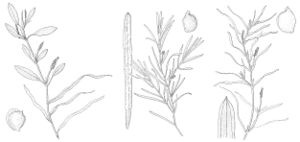Potamogeton epihydrus
Medical Repository 5: 354. 1808, hexade hexade 2; 3; 2:409. 1811.
Rhizomes present. Cauline stems flattened, without spots, 10–90 cm; glands absent. Turions absent. Leaves both submersed and floating or floating absent, ± spirally arranged. Submersed leaves sessile, lax; stipules persistent, inconspicuous, convolute, free from blade, red-brown, not ligulate, 1–3 cm, not fibrous, not shredding at tip, apex obtuse; blade red-brown to light green, linear, not arcuate, 5–22 cm × 1–10 mm, base not clasping, without basal lobes, margins entire, not crispate, apex not hoodlike, blunt to acute, lacunae present, broad band each side of midvein; veins 3–13. Floating leaves petiolate; petioles continuous in color to apex, 2–12.5 cm; blade adaxially light green, narrowly oblong-oblanceolate to elliptic, 2–8 cm × 4–20 mm, base acute, apex rounded or bluntly cuspidate; veins 11–41. Inflorescences unbranched, emersed; peduncles not dimorphic, axillary, erect, cylindric, 1.5–5(–16) cm; spikes not dimorphic, cylindric, 0.8–4 cm. Fruits sessile, greenish brown, round-obovoid, flattened, abaxially and laterally keeled, 2.5–4.5 × 2–3.6 mm, lateral keels without sharp points; beak erect, 0.5 mm; sides without basal tubercles; embryo with less than 1 full spiral. 2n = 26.
Phenology: Flowering summer–fall.
Habitat: Still or flowing waters of lakes, ponds, streams, and rivers
Elevation: 10–1900 m
Distribution

St. Pierre and Miquelon, B.C., Man., N.B., Nfld. and Labr., N.S., Ont., P.E.I., Que., Sask., Ala., Alaska, Calif., Conn., Colo., Del., Fla., Ga., Idaho, Ind., Iowa, La., Maine, Md., Mass., Mich., Minn., Miss., Mont., N.H., N.J., N.Y., N.C., Ohio, Oreg., Pa., R.I., S.C., S.Dak., Tenn., Utah, Vt., Va., Wash., W.Va., Wis., Wyo., Europe.
Discussion
No specimens have been seen from Maryland, but the species is to be expected there.
Two varieties, Potamogeton epihydrus var. epihydrus and var. ramosus, have been recognized. These prove not to be distinct. Both varieties often grow in the same body of water in the same population. The wider-leaved plants often occur in more alkaline waters. Two hybrids, P. epihydrus var. nuttallii × P. gramineus and P. epihydrus × P. nodosus (= P. ×subsessilis Hagström), have been described.
Potamogeton epihydrus is a common species of lakes and streams of northern United States and southern Canada. It extends southward in the eastern United States to Louisiana and Alabama. Potamogeton epihydrus is one of our more easily recognized species: it has floating leaves, linear submersed leaves, and fruits with an embryo with one full spiral or less. The only other North American pondweed with a similar set of characteristics is P. tennesseensis, which differs from P. epihydrus by the former having long tapering apices in the submersed leaves whereas the latter has blunt to acute apices.
Selected References
None.
